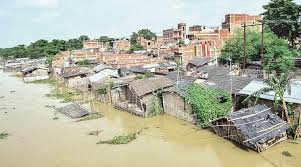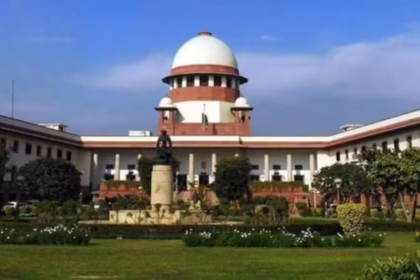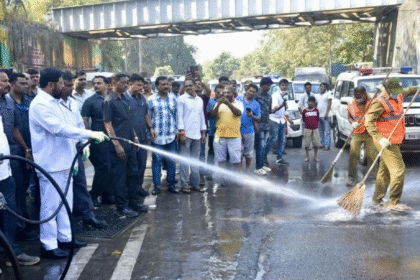Bihar SIR Draft Reveals Highest Exclusion in Poorest and Flood-Prone Districts
New Delhi: The top ten districts with the highest exclusions in the draft roll published by the Election Commission of India in Bihar under the Special Intensive Revision (SIR) includes some of the poorest districts in the state, which have Muslim dominated populations and are prone to intense out-migration.
Four of the top ten districts with the highest exclusion rates figure among the state’s top ten poorest districts in terms of multi dimensional poverty. These are: Purnia, Kishanganj, Sitamarhi and Saharsa. Of these, Purnia, Kishanganj and Sitamarhi along with Madhubani also figure among the state’s ten largest Muslim dominated districts, indicating intersectional backwardness.
Purnia, which has the second highest exclusion rate, figures among the state’s ten largest Muslim dominated districts, ten multi-dimensionally poor districts, is known for its high migration as well as figures among the state’s top five Scheduled Tribes (ST) dominant districts.
The top ten districts with the highest exclusion rates according to the draft roll published on August 1 include Gopalganj (15.09%), Purnia (12.07%), Kishanganj (11.82%), Madhubani (10.44%), Bhagalpur (10.19%), Saharsa (9.45), Sitamarhi (9.32%), Samastipur (9.02%), Saran (8.71%), Sheohar (8.69%).
TABLE: TOP 10 DISTRICTS WITH HIGHEST EXCLUSIONS
| DISTRICT | EXCLUSION RATE |
| GOPALGANJ | 15.09% |
| PURNIA | 12.07% |
| KISHANGANJ | 11.82% |
| MADHUBANI | 10.44% |
| BHAGALPUR | 10.19% |
| SAHARSA | 9.45% |
| SITAMARHI | 9.32% |
| SAMASTIPUR | 9.02% |
| SARAN | 8.71% |
| SHEOHAR | 8.69% |
*2nd, 3rd and 8th row indicate those districts which feature in top ten multi-dimensionally poor districts in the state and are among the state’s top ten districts with largest Muslim populations.
*5th row indicates districts that are among the state’s top ten districts with largest Muslim populations but not among top ten multi dimensionally poor districts in the state
*7th row indicates district that is in top ten multi dimensionally poor districts in the state but not among the state’s top ten districts with largest Muslim populations
Four districts among the poorest in the state
Of the ten districts that have the highest exclusion rates, four, including Purnia, Kishanganj, Sitamarhi, and Saharsa are among the worst ten multi-dimensionally poor districts according to the NITI Aayog’s multi-dimensional poverty index published in 2023 which was based on the NFHS-5 (2019-21) data.
Incidentally, according to the Niti Aayog report, 33% of Bihar’s population is multi-dimensionally poor – the highest among all states.
In the report, Purnia ranks second in the state with 50.70% and Saharsa ranks fourth with 49% of its population being multidimensionally poor. Kishanganj ranks sixth in the state with 45.55% and Sitamarhi ranks eighth with 42.82% of its population being multi-dimensionally poor.
According to NFHS 5 data, Sitamarhi also ranks fifth among the ten districts in the country that have the highest prevalence of malnutrition among children under the age of five at 54.2%.
Additionally, Madhubani and Samastipur, which also figure in the top ten districts with the highest exclusion rates in the draft rolls, are among the state’s five highest burden districts for anaemia among pregnant and non-pregnant women respectively, according to a study by POSHAN think tank using data from NFHS-5.
Four districts among the largest Muslim dominant populations in the state
Some of the districts with the highest exclusion rates also figure among the state’s top ten districts that have the highest Muslim populations.
Purnia, Kishanganj and Sitamarhi are both part of the top ten multi-dimensionally poor as well as among top ten Muslim dominated districts in the state. Madhubani, which is also in the top ten districts with highest exclusion rate, also figures in the state’s top ten Muslim dominant districts.
The state’s ten largest Muslim populated districts according to Bihar State Minority Commission data include Kishanganj (67%), Katihar (42.5%), Araria (41.13%), Purnia (36.76%), Darbhanga (22.72%), West Champaran (21.24%), Sitamarhi (21.20%), East Champaran (19.16%), Siwan (18.2%) and Madhubani (17.94%).
Of the ten districts with the highest exclusion rates from the draft rolls, Purnia, has the distinction of being part of the top ten multi-dimensionally poor, among top ten Muslim dominated districts, as well as among the top five Scheduled Tribes dominant districts in the state.
Poorer the population higher the migration
While the ECI has said that the one-month period of filing claims and objections is underway and only the final roll published next month will reveal the real extent of exclusions, the data from the draft roll shows that there exists a correlation between poverty, migration and deletions.
“There is a strong co-relation between poverty and migration because if the districts are poor, it means people are poor because they are unable to find meaningful employment. Out-migration is likely to be higher in these districts because people are going out in search of work,” said Sanjay Kumar, co-director, Lokniti, Centre for the Study of Developing Societies.
“It is likely that these people’s names were on the list but they were not home when the revision took place. Deletion may be higher for those who are temporarily migrated from their home towns. Therefore, there is some relationship. Higher poverty would mean higher migration rate and higher migration rate would have resulted in higher proportion of deletions in these districts.”
The ECI has said that a total of 7.24 crore forms have been collected of the 7.89 crore electors in the state between June 24 to July 25 during the SIR. Of the about 65 lakh people who have been left out of the draft roll, according to ECI data, 22.3 lakh are dead, 36.2 lakh have permanently shifted, while another 7.01 lakh are enrolled in more than one place.
This has raised concerns about migrant workers being left out of the electoral rolls due to their non-availability at homes, resulting in their inability to fill the enumeration forms. There are fears over the robustness of the process of declaring someone as having “permanently migrated” in such a rush. It is not clear if the ECI has made the effort to examine if they are enrolled on voter lists in other states before striking them off the draft.
In July 2023, the Union government told parliament that the migrant workers population in Bihar is 7,06,557, citing data from the 2011 Census.
Opposition leaders in Bihar have also demanded a clarification from the poll body on how it has established that 36 lakh voters have migrated and are not simply migrant workers who are temporarily working in other states.
“Let [the] EC clarify. If the names of 36 lakh poor voters are removed due to temporary migration, then this figure should be higher than the 3 crore registered workers who migrate out of Bihar annually, as per the Government of India’s own data,” said Bihar leader of opposition and former deputy chief minister from the RJD Tejashwi Yadav on Saturday.
In July 2024, the Union government told the parliament that more than 2.9 crore unorganised workers, including migrant workers, have registered on the eShram portal.
Flood-prone districts
A study by the Institute of Population Sciences (IIPS) found in 2020 that regions in North Bihar (Saran, Darbhanga, Kosi, Purnia, and Tirhut) that “experience recurring and frequent floods have a higher migration intensity (greater than 55%) than the divisions of the south such as Patna, Madadh, and Bhagalpur, where the migration levels are lower (less than 40%).”
Purnia and Saran are ranked second and ninth in the top ten districts with the highest exclusion rates, data from the draft rolls show.
The IIPS study for instance mentioned that 62.5% were migrant households in Saran, and 51.8% in Purnia.
Former Chief Election Commissioner O.P. Rawat last month also raised concerns about the timing of the exercise that would affect migrant workers as well as the existing population in Bihar due to floods.
“If time (for this exercise) was a year or year and half, there would have been no hue and cry. Time is short, elections are around the corner. These documents cannot be easily procured, as it is also the season of floods and heavy rain,” he said.
A report from the Stranded Workers Action Network (SWAN) that surveyed 338 migrant workers between July 19 and 21, found that 90% of migrant workers currently outside Bihar had not heard of the revision, 75% were unaware of the poll body’s online portal for submitting forms, and less than 1% had used it.
In an interview with Karan Thapar, Yogendra Yadav, the National Convener of the Bharat Jodo Abhiyan, said that the idea that migrant workers who are working in far away states would come back home or “they would upload the form, make a signature, download, upload, signature, all this is fiction existing in some Babu’s room in Delhi.”
“Nothing of that kind is happening. And those migrant workers who have been able to fill their form is only because someone in their family went to the BLO and said, ‘Please fill my brother’s form’ but all this is just plain fraudulent activity that is happening,” he said.
“I do not blame those workers. What would you do? Will you come back home? This is not the time when workers of Bihar come home. They come home during Chhath, which is another 2-3 months away. How can they possibly come to do this exercise? All this is worse than a joke. And as all over the world, whenever documentation barriers are raised, it is the disadvantaged who get excluded.”
Too early to cut through the chaos
A survey by The Convergent Media that focussed on the Dalit population found that 71% feared disenfranchisement. Prem Kumar, a senior journalist in Bihar and director of The Convergent Media said that it was too early to make any definite conclusions.
Kumar said that in the 2020 Bihar assembly elections, the 11 seats which were won by less than 1,000 votes, or about 70-odd seats that were won by 10,000 votes, is where that deletions can play a role.
“At the moment it is difficult to say anything on the existing data. It is a proven fact that any such exercise will see deletions from Muslim and Dalit voters. While this alertness may be there among Muslims to ensure their names are included, it is not there among Dalits. Districts like Kishanganj, Purnea, Araria are flood-affected areas where the dangers of exclusion are more. Yet, I would still say that to establish this as a fact will need more time.”
Noting the concerns arising out of the draft roll, observers believe that it is too early to draw any definitive conclusions about the extent of exclusions, or specific groups being left out at the moment. It would be important to keep an eye on how the EC acts this month to reconcile the draft with complaints and the ground reality. The Supreme Court is set to hear petitioners next week on August 12 and 13.








